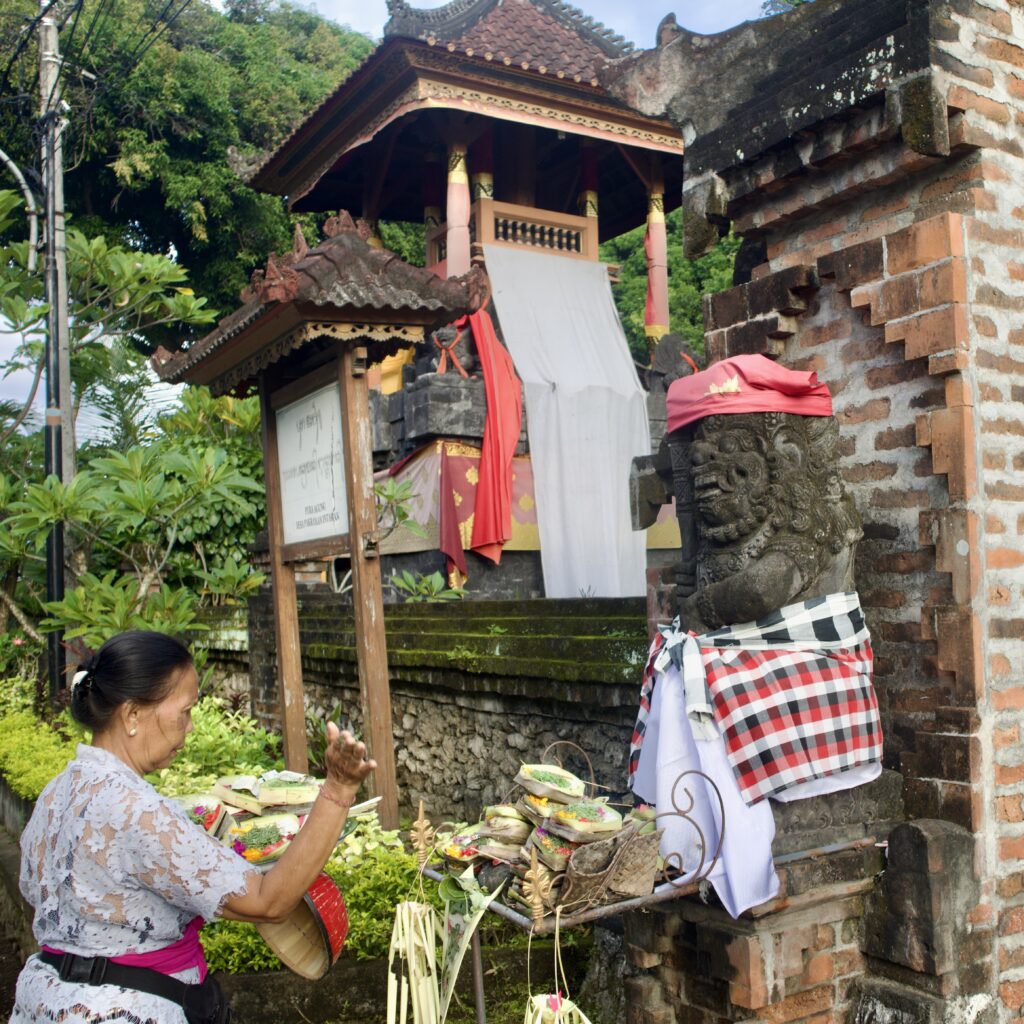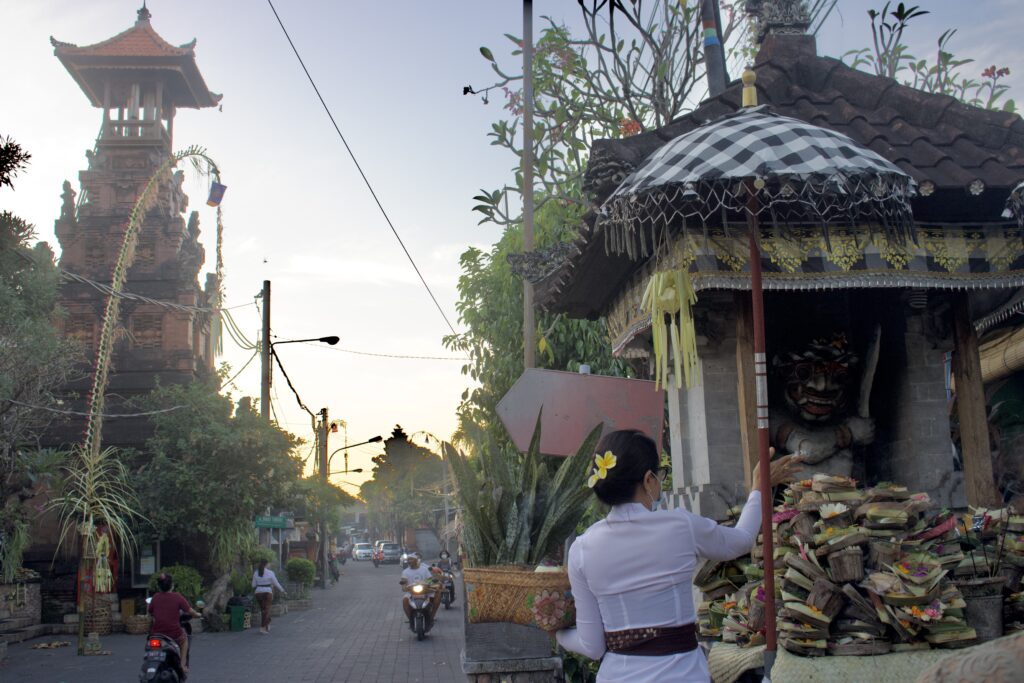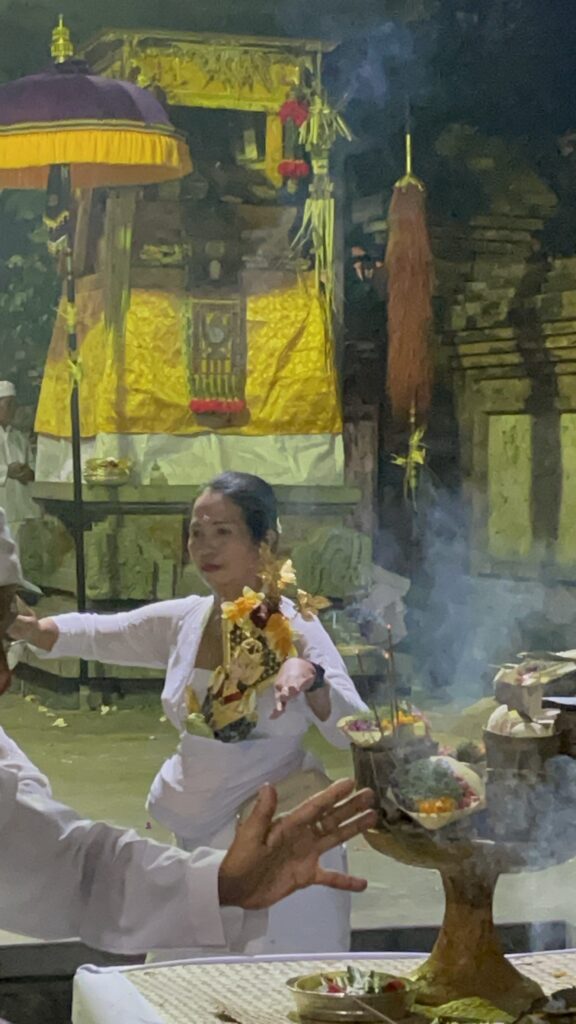This is a look back at the recent Tumpek Wayang ceremony in Sanur, a profound ancient ritual where the Barong Landung couple, Jero Gede and Jero Loeh, were reverently escorted through the streets. Sanur, with its magical temples, ongoing ceremonies, and as the home of High Priest families—the custodians of Balinese Hinduism—stands as the spiritual gem of Bali.
The included pictures aim to capture these breathtaking moments, though words and images can hardly do justice to the awe-inspiring nature of Tumpek Wayang and other Balinese rituals. During these sacred times, an unseen mystery fills the air, emerging from the unknown. At every step, there are surprising turns of events, with the Pemangkus—the temple priests, providing direction as if guided by invisible hands, performing with the utmost naturalness, dignity, and calmness.
The Morning Ambiance of Sanur




As dawn breaks, the loud choruses of birds echo through the air, like a galaxy breaming with stars, heralding the rising sun over the Java Sea. This celestial event soon bathes the serene, east-facing beachfront, red-tiled rooftops, and the charming homes and temples of Sanur in a golden glow. These tranquil moments of morning awakening, accompanied by the melodies of tropical birds, are further enriched by the vibrant traditional markets—Pasar Sindhu and Pasar Intaran—that encapsulate the essence of Balinese daily life and cultural richness. Most notably, this is the time for the ritual of laying Balinese offerings, a deeply rooted tradition observed by the local population in the early morning.





Particularly scenic and delightful are the sights of both women and men, wrapped in traditional Balinese kamens or kains with vibrant sashes around their waists, delivering and wafting the smoke of canang sari offerings around homes, shops, street shrines, and temples. Canang are small square baskets, often made from young coconut leaves, filled with fresh flowers and various symbolic ingredients. Together, they represent the essence of offerings sent to the divine, creating a stunning morning ambiance unique to Bali. The combined fragrance of flowers and incense in each offering fills the air, uplifting and enveloping the mind in a spell of addictive purity.
On the previous day, preparations were made for Tumpek Wayang, an important Balinese temple ritual that occurs twice annually according to the traditional Balinese calendar. This sacred day is dedicated to the worship of holy puppets, an extensive collection of ritual masks depicting various otherworldly characters, and the diverse tools used in Bali’s sacred theatrical performances. Among the most prominent of these performances are the masked Topeng and the shadow puppet play wayang kulit. Tumpek Wayang pays homage to the deities who are considered the divine benefactors of the arts, particularly the traditional theatrical arts of Bali.
In Balinese culture, rich storytelling forms are not merely for entertainment; they serve as offerings themselves, fulfilling their purpose to invoke the gods and maintain harmony between the material and spiritual worlds.
While the overarching theme of Tumpek Wayang provides a general picture, it captures only a fragment of what unfolds on this extraordinary day. The oldest streets and temples of Sanur are steeped in mystery, as if the spirits of the past walk among the living. This atmosphere seems to permeate Sanur and much of Bali, where the veil between the earthly and ethereal feels thin and almost perceptible.
The Enchanting Rituals of Barong Landung in Sanur
The powerful inner spirit of Bali is vividly displayed in the ceremonial parades of various temple gods, often proceeding to the nearest beach in Sanur, accompanied by the enchanting sounds of the gamelan music and ancient Kidung chanting. Today, without the grand pomp typical of major Balinese ceremonies, the Barong, symbolizing positive forces, and Rangda, representing negative forces, accompany the renowned ancient Barong Landung deities of Sanur in a special procession to nearby temples. The beautiful temples of Sanur are interconnected in a mysterious network of relatedness and ‘family connections’ among the temple gods.
As evening falls, the local community, numbering a few hundred people, gathers to welcome the return of Barong Landung at the sacred Pura Taman Segara (Ocean Garden Temple), located at the intersection of the old Sanur streets, Jl. Danau Buyan and Jl. Danau Beratan. The stage is prepared for the main prayer and a series of splendid offerings. As always, pemangku priests, the dedicated caretakers of the temples and experts in the intricate complexities of Banten—the Balinese offerings, orchestrate the elaborate ritual.
Two towering Landung figures emerge from the dimly lit streets of Sanur: Jero Gede, the imposing male figure with long black hair, and Jero Loeh, the female counterpart with a lustrous face and enigmatic smile. These sacred Barong Landung effigies evoke awe and reverence, symbolizing the deepest secrets of Sanur’s mystical interior, where many divine beings reside.
In Balinese Hindu culture, the Barong is a powerful symbol of virtue and the divine protector of the invisible realm of spirits. Often depicted as a lion-like creature, this mythological figure is central to numerous traditional Balinese temple ceremonies across the island. The Barong plays a pivotal role in Bali’s rich cultural and spiritual life, appearing prominently in sacred dances, rituals, and folklore.
The most familiar form of the Barong resembles a lion, covered in a coat of hair or, more rarely, adorned with exquisite black crow feathers. The Barong’s distinct human-like beard is believed to be the source of magical powers, particularly during Balinese trance rituals. Among the many less commonly seen animal forms of Barong, each with unique symbolism, Barong Macan resembles a tiger, Barong Bangkal a boar, and Barong Menjangan a deer. Today, the illustrious Barong Landung holds a special place, represented by giant male and female puppets, revered as protectors of the island and embodiments of mystical power.
The celestial, enigmatic face of Jero Loeh, the female embodiment of divine grace and mystery, is carved with exquisite detail. Her pronounced forehead and chin, coupled with her tranquil gaze and celestial elegance, intensify the mystique. The soft contours of her features are framed by a lustrous golden headdress, intricately designed with floral motifs. Her costume, featuring flowing batiks with vibrant hues of red and gold, is complemented with rich details of embroidery and golden beadwork.


Jero Gede, the male counterpart, stands about 3 meters tall, exuding an air of commanding authority. His face bears an expression that is both serene and ferocious. His large, white teeth, sharply defined, stand out against his dark face, emphasizing his role as a protective deity in the eternal battle against malevolent forces. Draped in Balinese prada fabrics of deep red and rich gold, and adorned with the striking black and white saput poleng (the Balinese sacred checkered pattern), he radiates mystical power. His waist is cinched with a belt featuring the figure of Bhoma, an ancient protective symbol that hails from the early history of Balinese and Javanese culture. Golden cuffs adorn his wrists, and a snake head prominently sits on his forehead, directly above his intense and penetrating eyes. Softening his formidable features, a heap of fragrant chempaka flowers is placed over the blackness of his long hair and torso.

Each layer of attire on Jero Gede and Jero Loeh shimmered with grace under the strong reflector lighting, further enhancing their already radiant presence.
The Barong Landung figures, embodiments of Balinese mythology, now stand alongside accompanying temple deities as the entire community sits on the ground, participating in ceremonial prayers before them. This sacred event takes place right in front of the main gate of Pura Taman Segara, beautifully adorned with yellow and golden sacred fabrics, as well as various decorative and ritualistic elements.

Under the effect of bright lights, the Barong Landung puppets and the stylishly attired women carrying offerings blend traditional sacredness with an avant-garde fashion sense. As in most other significant temple events, the ambiance is celestial, a dreamy fairytale infused with rich colors. Even the guardian statues flanking the temple gates seem alive and participatory, contributing to the surreal and unearthly atmosphere.
After the prayer, the local pemangku priest sprinkles the holy water, or tirta, over the crowd, who burst into laughter as he playfully teases them. Even the most sacred moments of Bali’s traditional customs are filled with cheer and joy!

The King and Queen of the ethereal realm are then carefully escorted through the narrow temple gates to the holy ‘bale’ pavilion, a podium-like shrine within the temple. Before being reinstalled in their respective positions, their clothing, masks, and decorative embellishments undergo meticulous inspection. This process involves careful reassessment, adjustment, and reassembly to address any wear and tear from the day’s intense outing in Sanur. It’s always remarkable to witness the Balinese’s exceptional attention to detail and the care they show for their cherished objects.

Following this is an awe-inspiring final ritual performed by the Balinese pemangkus. The traditional sacred offering dance, known as ngayah, is one of the most graceful and artistic devotional rituals, integral to significant ceremonies in Bali, such as temple odalan anniversaries.

Both male and female pemangkus, both elderly and young, participate in this meditative dance, carrying flower offerings and incense, spreading the sacred essence throughout the temple grounds and before each altar. Their bodies move gracefully to the sounds of holy hymns and gamelan music, purifying the temple’s inner and outer spaces, creating a welcoming environment for deities and ancestral spirits. Unlike more complex Balinese dances, this devotional prayer dance, ngayah, is characterized by its simplicity, yet it is deep, meditative, and visually captivating.

Witnessing the Tumpek Wayang ceremony and the processions of Barong Landung is an unforgettable experience, offering a rare glimpse into the heart of Bali’s rich heritage. Compared to other major festival events in Sanur, Tumpek Wayang is quieter and more discreet. Nevertheless, with the mysterious Landung puppets taking center stage, it remains one of the most impressive and immersive experiences, allowing one to explore and appreciate the depth of Balinese cultural traditions.



Leave a Reply